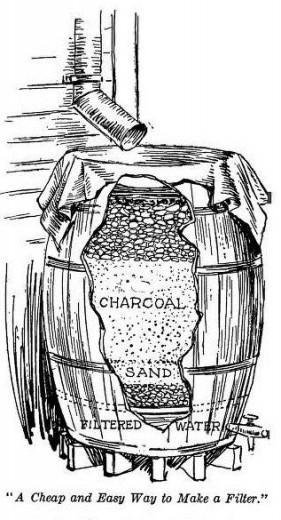Water is the essence of life, and its sustainable management is crucial for our survival. With growing concerns over climate change, water scarcity, and pollution, individuals and communities are increasingly looking for eco-friendly ways to secure their water supply. One time-tested method that has been used for centuries is filtering rainwater in a barrel. In this article, we will look into the 100-year-old way of filtering rainwater in a barrel, explore the compelling reasons for doing so, and provide step-by-step instructions on how to implement this sustainable practice.
Materials Needed
Before we begin, gather the following materials:
- Rain Barrel: You’ll need a sturdy rain barrel with a tight-fitting lid. You can purchase one or repurpose an old barrel.
- Screen Material: Obtain a piece of fine mesh screen material or nylon pantyhose to act as a first-level filter to prevent debris from entering the barrel.
- Coarse Gravel: You’ll need a layer of coarse gravel to serve as the second filter.
- Activated Charcoal: Activated charcoal will help remove impurities and odors from the rainwater. You can find it in gardening or aquarium supply stores.
- Fine Sand: A layer of fine sand is necessary for the third filter.
- Small Rocks or Pebbles: These will provide additional filtration.
- Tools: Gather a few basic tools, including a saw, drill, hammer, and nails.
The Whys and Hows of Filtering Rainwater
Benefits of this Centuries-Old Method
Filtering rainwater in a barrel using the centuries-old method has numerous compelling reasons why someone would want to embrace this sustainable practice:
- Water Conservation: One of the most significant advantages is water conservation. By collecting rainwater, you can reduce your reliance on traditional water sources, such as municipal supplies or groundwater. This not only helps conserve precious freshwater resources but also eases the burden on water treatment facilities, reducing energy consumption and associated carbon emissions.
- Cost Savings: Filtering rainwater is a cost-effective way to obtain clean water for various household uses, such as watering plants, washing vehicles, or even flushing toilets. By harnessing nature’s gift, you can lower your water bills and achieve long-term savings, making it an economically viable choice.
- Environmental Responsibility: With increasing concerns about environmental sustainability and climate change, harvesting rainwater demonstrates a commitment to responsible environmental practices. It reduces the demand for water from natural sources, minimizing the environmental impact associated with water extraction and distribution.
- Resilience in Drought-Prone Areas: In regions prone to drought or water restrictions, having a rainwater collection system in place can provide a reliable source of water during dry spells. This resilience can be invaluable for maintaining landscapes, gardens, and even ensuring basic water needs are met when traditional supplies are limited.
- Improved Water Quality: Rainwater collected using this filtration method is often of higher quality compared to untreated rainwater or well water. The multi-layered filtration system effectively removes impurities, contaminants, and debris, resulting in cleaner water suitable for various domestic and outdoor applications.
- Reduced Stormwater Runoff: Collecting rainwater also helps mitigate the negative effects of stormwater runoff. By capturing rain before it flows into storm drains, you can reduce the risk of local flooding, soil erosion, and the pollution of natural water bodies with pollutants carried by runoff.
- Community and Educational Benefits: Implementing a rainwater harvesting system can serve as an educational tool for children and the community. It fosters awareness about water conservation, sustainable living, and responsible resource management, inspiring others to adopt similar practices.
Step-by-Step Instructions
- Prepare the Barrel:
- Start by drilling a hole near the bottom of the barrel. This will be your water outlet, so make sure it’s large enough to fit a spigot.
- Attach a spigot to the hole securely. You may need a washer or gasket to prevent leaks.
- Place the barrel on a stable, elevated surface like cinder blocks to create space for a container under the spigot.
- Create the First Filter:
- Cut a piece of mesh screen material or use nylon pantyhose to fit over the top of the barrel.
- Secure it in place with a rubber band or by tightly wrapping it around the barrel’s top.
- Layer the Filters:
- Inside the barrel, begin layering your filtration materials. The sequence should be as follows, from bottom to top:
- Coarse gravel (3-4 inches)
- Activated charcoal (1-2 inches)
- Fine sand (1-2 inches)
- Small rocks or pebbles (1-2 inches)
- Inside the barrel, begin layering your filtration materials. The sequence should be as follows, from bottom to top:
- Seal the Barrel:
- Cover the top of the barrel with the mesh screen or nylon pantyhose and secure it tightly.
- Place the lid on the barrel to keep out debris and prevent evaporation.
- Collect Rainwater:
- Position your barrel in an open area where rainwater can easily flow into it. Ensure the downspout from your roof directs water into the barrel.
- When it rains, water will pass through the filtration layers, removing impurities and debris, and collect at the bottom of the barrel.
- Maintenance:
- Periodically check the barrel and clean or replace the filtration materials as needed. Activated charcoal, in particular, may need replacement every few months.
In conclusion, filtering rainwater in a barrel using this time-honored method not only offers practical advantages but also aligns with the principles of environmental responsibility and sustainability. It empowers individuals and communities to take control of their water supply, reduce their ecological footprint, and contribute to a more resilient and environmentally conscious future. By embracing this centuries-old practice, we can pave the way for a sustainable and water-wise world.
See More Here: Rainwater Harvesting for Your Backyard Farm

